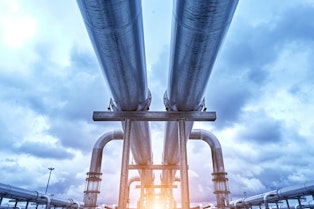Hydrogen is defined as ‘green’ when produced by the electrolysis of water using electricity generated from renewable resources. This contrasts with today’s ‘grey’ hydrogen, which is derived from fossil fuels.
With zero carbon emissions, green hydrogen could be key to powering sectors that rely on molecular fuels, such as shipping and heavy industry. And after many years of false dawns, it seems green hydrogen is finally ready to dramatically expand.
According to a recent report, after stalling a little in 2020 due to COVID-19 lockdowns, the global green hydrogen market is projected to hit $9.8 billion by 2028, with an impressive compound annual growth rate of almost 55% from 2021 to 2028.
The report identifies green hydrogen’s increasingly recognized potential as an energy carrier in the emerging low-carbon economy as the main reason for its projected growth. Hydrogen’s advantages as a clean-burning fuel which produces only water on combustion are clear.
But its adoption faces practical challenges. As a light gas with a low energy density when compared with gasoline, it is needed in large volumes to generate significant amounts of energy.
Liquefying hydrogen to reduce its volume is a challenge, too, because it requires the temperature of the gas to be lowered to minus 253 degrees centigrade.

With the total hydrogen demand in Europe expected to grow to more than 45 million tonnes by 2050, a big challenge to the hydrogen economy is how those millions of tonnes will be delivered to where they are needed.
While there is growing investment in hydrogen production, the challenge of getting the gas from often remote areas, where renewable energy is cheapest, to centers of population and industry is often overlooked.
At first sight, pipelines for gaseous hydrogen seem to be the obvious solution, given these have worked so well for natural gas and the technologies involved have been fully developed.
Operation costs would be low, and the environmental impact and public more favorable than electricity transmission lines. However, the capital costs would be high, even if some of the existing natural gas infrastructure could be adapted for hydrogen.
In addition to the pipelines themselves, a comprehensive hydrogen network would also need compressors and decompressors, and storage facilities as a hedge against volatile supply, as well as metering and other control mechanisms.
And it is unclear whether using the existing natural gas infrastructure to pipe hydrogen will be a feasible option. Due to material compatibility, there are concerns about the viability of repurposing old natural gas pipelines purely for hydrogen.
For now, gas companies across Europe and beyond are expressing optimism that their networks can take hydrogen. The first tentative step is to blend hydrogen with natural gas in existing pipelines.
In the UK, utilities National Grid and Scottish Gas Network are putting hydrogen into pipelines to fuel power plants and industrial processes, homes and businesses.
Concentrations are currently less than 20% but both companies have ambitions to eventually increase this to 100%.
According to Mona Dajani, head of the renewable energy and green hydrogen practice of law firm Pillsbury Winthrop Shaw Pittman, “Pipeline injection is a national hydrogen strategy for the Netherlands, for Germany, for France, for Australia, for South Korea, for Japan.”

Meanwhile in the US there is a smattering of pilot projects in Utah, California and New York state, with ambitions ranging from a region-wide green hydrogen production and storage complex to injecting from 1% to 10% hydrogen into delivered natural gas.
Yet while pipelines might work for bulk hydrogen transport, adapting the entire distribution network is another matter. And given that outside of gas utilities there is widespread skepticism towards the piping of hydrogen, it is important to explore alternatives.
As mentioned earlier, liquid hydrogen would reduce the volume required in transportation and increase the fuel’s energy density but requires very low temperatures to be viable.
Not only is the refrigeration required highly costly in terms of energy but also the risks of liquid hydrogen simply vaporizing and escaping from the system would mean costly losses could be significant.
Another option is to convert green hydrogen to ammonia, a bulk chemical that is normally synthesized from natural gas and mainly used as chemical feedstock, such as in fertilizer production.
Ammonia is currently synthesized from natural gas but could be widely leveraged as a clean hydrogen storage medium. Indeed, until the 1960s, most fertilizers in Europe were produced from ammonia synthesized from hydropower-generated hydrogen.
Ammonia has been used and transported worldwide for decades, so the technology is already tried and trusted. The big downside is ammonia’s safety issues. A highly toxic, volatile substance, it needs extensive precautions against leaks and explosions.
And while manufacturing ammonia is straightforward, the process of cracking it to release the hydrogen gas is at a very early stage of technological development and is very energy intensive.
Finally, liquid organic hydrogen carriers (LOHCs) such as benzyltoluene are easily transported chemical compounds that can be reversibly hydrogenated and dehydrogenated. There is much to recommend LOHCs as a medium for hydrogen transportation.
They are safe, easy to store and handle and can use existing infrastructure such as trucks or vessels. They also do not incur hydrogen losses, allowing long storage durations and storage of large volumes.
On the downside, the long-term viability of LOHCs in the real world has yet to be proven, although pilot programs are yielding positive indicators. In addition, the process for liberating hydrogen from its carrier liquid is energy intensive.
In conclusion, although the future seems to be bright for green hydrogen, it is still not clear how it will be distributed, and it would be ill-advised to assume one method will predominate in all situations.
To begin with, the simplest strategy may be to locate hydrogen production close to demand centers that may already be seeing development of energy park infrastructure such as battery plants.
Such green hydrogen hubs are projects that Pacific Green can develop wherever needed, anywhere in the world. If you want to find out more, then get in touch now.
Publish date: 18 October, 2022